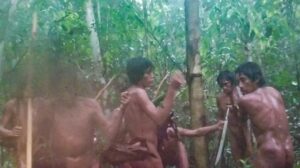Striking images captured by automatic cameras in Brazil’s tropical rainforest reveal an isolated indigenous community living in the Amazon, known as the Massaco.
The community was named Massaco after the river that traverses their territory, but no one knows how they refer to themselves. Their language, social structure, and beliefs remain shrouded in mystery.
Despite increasing pressure from loggers, ranchers, and other illegal activities in the Amazon, the community continues to survive.
The photographs, taken by Brazil’s National Indian Foundation (Funai), provide significant insights into the growth of the Massaco population, which is believed to have doubled since the 1990s, now reaching approximately 200-250 individuals.
Funai placed cameras at a site where they periodically leave metal tools as gifts. This practice is used to prevent members of the tribe from attempting to enter farms or logging camps to obtain tools, which could have tragic consequences for the tribe.
Photos of the Massaco settlements have been taken before during Funai missions to areas identified through satellite images as abandoned.
The Massaco—who remain a mystery to the outside world—live nomadically, hunt with massive bows, and protect their territory by planting traps in the ground.

Approximately 61 communities have been confirmed to exist between the Amazon and the Gran Chaco region. However, there are another 128 communities that have yet to be verified by authorities, according to a draft report by the International Work Group for Indigenous Peoples in Isolation and Initial Contact.

Photo of an unknown Amazonian tribe in Peru, taken in 2011.
The report’s author, Antenor Vaz, was among the first to implement the policy of non-contact with the Massaco in 1988. He stated that Brazil has excelled in developing best practices in this field but lacks specific legislation to protect isolated peoples.
The policy of protecting isolated populations, first pioneered by Brazil in 1987, has become a model for countries like Peru and Colombia.
However, the Massaco, like other communities, face threats from illegal activities and a lack of institutional support. “These peoples have a right to their lives and their land, and their protection is key to the preservation of tropical forests,” said Paulo Moutinho, co-founder of the Amazon Environmental Research Institute, as reported by the Guardian.
Ask me anything
Explore related questions





